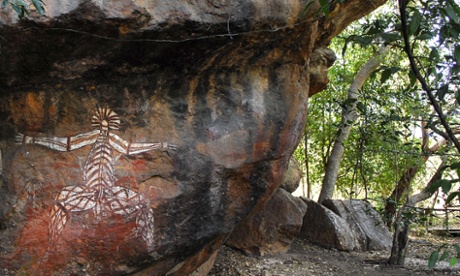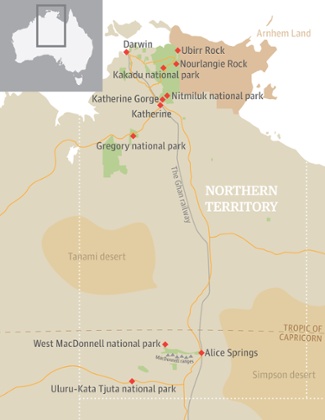
Australia may be one of the world’s youngest countries but it is also home to the planet’s oldest surviving civilisation and nowhere in the broad, sunburnt land is more suffused with that indigenous culture than the Northern Territory.
From the tropical north to the red deserts of central Australia, the Aboriginal presence dates back about 50,000 years.

Of all Australia’s major cities, Darwin is the most connected to that heritage, both as the domain of the Larrakia “saltwater people”, and as the gateway to unfathomably old ancestral lands beyond.
To the north 80km away, straddling the Arafura and Timor seas, are the exotic Tiwi islands, where the small population of 3,000 produce distinctive artwork across a range of styles including fabric design, wood carving and ceramics.
Inland and to the east, secreted within a theatrical backdrop of escarpments, waterfalls, gorges and flood plains, are some of the world’s most significant rock art galleries in Nitmiluk and Kakadu national parks and Arnhem Land.
Arriving in Darwin, the Museum and Art Gallery of the Northern Territory provides an excellent introduction to the region’s diverse culture and history. Indigenous-owned galleries around this balmy seaside city also shed light on the varying art styles from the whole region – from ironwood funeral poles fashioned in the Tiwis and the bark painting tradition in the north to dot-style work from the central deserts.
A leisurely three-hour drive to the south, in Katherine, the award-winning Top Didj cultural experience tours are led by Dalabon artist Manuel Pamkal, from Arnhem Land, who teaches visitors “rark” – crosshatched-style painting. After Pamkal describes his upbringing and spiritual relationship with the land, he guides visitors through the creation of their artwork using fine brushes, made from reeds. Later, he shares the secrets of making fire with two sticks and dried grass, and of throwing a spear using a pivot-like woomera.
Just minutes down the road, in Nitmiluk national park, the indigenous-owned Cicada Lodge, is a luxurious eco-resort from which to see Katherine Gorge, a system of 13 canyons sliced into the sandstone plateau by the Katherine river. Visitors can paddle kayaks beneath 67-metre high cliffs, take a sunset boat tour through the gorge walls or, thrillingly, fly over the escarpment by helicopter, stopping to visit remote rock art galleries painted by the Jawoyn people thousands of years ago.
When it comes to rock art, nowhere has more sites than Kakadu national park, to the north-east. For those with time, nine-day off-track walking tours with Australian Wilderness Adventures, reveal an Edenesque landscape that seems to reverberate with ancestral whisperings and in which nearly every rocky outcrop has caves and overhangs emblazoned with rarely viewed art.
More accessible sites at Nourlangie and Ubirr rocks record Aboriginal occupation dating back at least 20,000 years.
At Nourlangie, a one-mile walk leads through a hillside, which has provided shelter from wet season deluges for generation upon generation, to the extraordinary Anbangbang gallery, with its vivid depiction of Namarrgon, the lightning man.
At Ubirr, the rock art includes images of the rainbow serpent, which local Gagudju people believe was left by the creation spirit herself, a thylacine (Tasmanian tiger) that became extinct in mainland Australia about 2,000 years ago, and a “white fella” buffalo hunter from the 1880s.
At a lookout on top of Ubirr, the view across the floodplain gives a sense of the immense, abundant and sometimes inhospitable environment that shaped indigenous identity and belief systems. These are explained at the Bowali Visitor Centre, which defines Kakadu, as Aboriginals do, in terms of six seasons.
Information panels also outline the importance of water in this Unesco world heritage area, from the creeks and rivers twirling across its plateaus, to thundering falls like Twin and Jim Jim, to sedate billabongs like Yellow Waters, where regular boat tours reveal a wealth of birdlife such as osprey, honking magpie geese and azure kingfishers.
Beyond Kakadu is Arnhem Land – encompassing wetlands, waterways full of barramundi and crocodile, fractured ranges and ancient sacred sites. It’s best explored from Davidson’s Arnhem Land Safaris eco lodge, at Mount Borradaile.
The Red Centre
But, for many, it is the Red Centre with its monolithic rock formations that is most redolent of indigenous Australia. With its galleries of elaborate dot paintings from the Western and Central deserts, Alice Springs, a two-hour flight from Darwin, is the continent’s Aboriginal art capital and the place to begin the cultural journey.
Nearby, at the 13 sq km Alice Springs Desert Park, Aboriginal guides and a cultural centre help underline the strong connection between the land, its flora and fauna and its traditional owners.
“We connect to it, we’re a part of it,” says nature conservator Doris Kngwarraye Stuart of the bond, “Our country is our home, and we know all the sites and all the features, our rocks, our trees, our hills.”
To appreciate the vastness of the central desert, travel by car across the 460km umber-coloured sandscape to Uluru, the enormous red boulder appearing on the horizon like a mirage in the shimmering heat haze.
Spiritual presence
Uluru’s presence is even more powerful up close, often changing hue from bright orange at dawn to almost mauve at dusk.
To experience the spiritual presence of this ancient rock, try staying at the Ayers Rock Resort, with its indigenous cultural programmes, joining an Anangu guide to visit Uluru’s base and art sites, and dining with a view of the rock on a Sounds of Silence tour.
That energy is also palpable at nearby Kata Tjuta, particularly at dawn, when the rounded, sandstone domes appear like heavy-headed giants awaking from their slumber.
It brings together Taylor’s stories from his Arrernte heritage and native ingredients like bush tomato and kangaroo fillet cooked on a mulga-wood campfire, under an outback night sky strewn, like a piece of desert art, with intricate constellations.
Trailfinders – tailormade holidays to suit you
Explore the lush tropical top end under your own steam on a fly-drive holiday with Trailfinders before jetting down to the red centre where you can sit back and allow someone else to show you the sights. Twelve-night holidays cost from £2,659 including flights, eight nights in hotels with car hire and a five-day, four-night AAT Kings Red Centre tour with transfers and sightseeing – call Trailfinders on 020 7368 1200 to book.
How to get there
Fly to Australia with Malaysia Airlines which has twice-daily flights from London Heathrow to Sydney and Melbourne, plus daily connections to Brisbane, Adelaide and Perth and four connections to Darwin every week. Prices for return flights from London to Australia start from just £649. For more information and to book, visit malaysiaairlines.com







